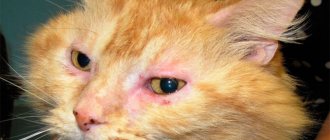Keratitis in cats is another of the most common ophthalmological diseases of pets. What kind of disease is this? Why does it happen? What types of keratitis in cats exist, as well as the main symptoms and methods of treating keratitis in cats at home, will be discussed in our article.
Keratitis is an inflammation of the cornea. Recognizing this disease is not so difficult, because normally the cornea is transparent and shiny. But as soon as the inflammatory process “captures” it, the eye immediately becomes cloudy. In most cases (almost 100%), keratitis in cats is acquired.
Causes
Next, we will look at the main causes of keratitis in cats in order from most likely to least likely:
- Often, keratitis in cats develops due to mechanical impact on the cornea (solid particles, grains of sand, dust particles, twigs and much more).
- Not less often, inflammation of the cornea develops together with conjunctivitis (inflammation of the conjunctiva - the mucous membrane of the eyelids). When a cat blinks, the mucous membrane of the eyelid is tightly adjacent to the cornea, and bacteria (and they will certainly appear on the sensitive inflamed tissue) enter the cornea, leading to an inflammatory process.
- Don’t forget about eye burns (thermal, chemical), which are difficult to treat.
- Infectious diseases. In this case, keratitis or keratoconjunctivitis will already be a symptom of an infectious disease (adenovirosis, herpes, calcivirosis and others). And the pet needs to be treated comprehensively, because local therapy will only remove the symptoms of eye diseases, but the underlying disease will “rage.”
- Allergy. She can develop into anything. And without qualified help it will be difficult to help your pet.
- Autoimmune.
- Blockage or inflammation of the tear glands. Because of this, the cornea and conjunctiva dry out.
- Vitamin deficiencies.
- Genetic predisposition.
Most often, Britons, Siamese, Persians, Sphynxes and American Smoothhairs are predisposed to keratitis.
Diagnosis of keratitis
The cause and extent of the disease can be diagnosed through a medical examination. To do this, swabs are made from the pet's eye, and blood is donated to the laboratory. Then the doctor excludes all kinds of injuries listed: eyelid inversions, wounds, any mechanical damage. Problems associated with diseases inside the eye are also excluded: cataracts, uveitis, glaucoma, tumors. The presence of fluid secreted from the eye is diagnosed and compared with standard indicators. In special cases, tests are taken for the presence of tumors or autoimmune processes.
Symptoms
Symptoms of keratitis in cats will allow the owner to recognize the disease in time and contact a veterinarian for help. Below we have prepared the most striking of them, as well as photos of the disease, so that you can understand more clearly whether you have encountered it.
- The cornea becomes cloudy and becomes as if rough (matte). And such a lesion can occur either in one eye or in both eyes at once.
- Sometimes the cornea grows blood vessels.
- Infiltration (fluid inside the cornea) accumulates, causing the upper layer of the eye to swell.
- It's leaking from the inflamed eye. The fur underneath is wet. Pus may accumulate in the corners.
- If the disease has gone too far, scars may occur. Alas, further therapy will not give visible results, the cat is going blind.
- Terrible photophobia. Agree, a healthy cat happily lies in the sun, but if the animal’s cornea is inflamed, then the mustache will hide from the bright rays of the sun or lamp.
Symptoms of the disorder
Signs of the disease are easy to identify in the early stages of infection. The infection is primarily visible due to clouding of the cat's eye. In a healthy state, the cornea looks shiny, but during keratitis activity it becomes dull. Due to the accumulation of bacteria in the eye, fluid begins to collect and swelling appears. The organs of vision begin to water heavily, and pus is released. The vessels cannot stand it, they begin to expand, which is why a red mesh appears.
The cat has a strong sensitivity to light, so the diseased eye is always closed. But at the same time, ulcerative keratitis in a cat does not cause severe discomfort. And at the last stage of the disease, scars appear on the eye. Experts clarify that it is impossible to get rid of the scars, because the cat quickly loses its vision. If sequestered keratitis develops, a dark spot appears on the center of the cornea. Veterinarian Ani Vilkhotskaya claims that in young animals the disease develops faster than in older animals.
Often the disease is characterized by poor appetite in the pet.
The disease is also accompanied by the following symptoms:
- decreased appetite;
- severe cramps;
- anxiety;
- hardening and discoloration of the cornea.
Treatment
Treatment of cats for keratitis at home always begins with eliminating the cause! Without this, it is simply impossible to restore normal vision to your pet. It is not so easy to get rid of corneal inflammation.
Yes, hormonal or antimicrobial drugs can give a positive result, but if the cause remains unresolved, then sooner or later the keratitis will return. Antibiotic eye drops are most commonly used. If fungi are to blame, then fungicidal agents are required. Unfortunately, antifungal drugs are prescribed for a very long course of treatment. And it is not always possible to achieve positive results.
If the cause is a virus, then it is necessary to use specific serums. Without them, recovery will be almost impossible. But once the mustache is cured of the underlying (viral or even bacterial) disease, keratitis in cats goes away on its own.
Types of keratitis and diagnosis
There are several types of the disease:
- Ulcerative keratitis. It will most likely be caused by eye injury. An ulcer forms on the corneal tissue, which in its advanced form turns into purulent keratitis. It proceeds slowly. Since the cornea is insensitive in this form, it does not cause discomfort to the cat.
- Chronic degenerative keratitis is more common in certain breeds such as Siamese, Persian, Himalayan and Burmese (breeds with short faces and large eyes), so it is thought to be caused by genetic factors, or may be caused by frequent eye infections;
- Eosinophilic keratitis is a condition that begins as keratitis but progresses until the cornea turns pinkish and the affected eye becomes covered with a white film, most often caused by a herpes virus infection.
A cat that is suspected of having an eye disease should be examined by a veterinarian. Symptoms can be clearly visible to the eye infection and the host.
The veterinarian will examine the corneal tissue under a microscope to see if it is damaged or if there are any viruses causing irritation. A culture test will be performed. The condition of both eyes is analyzed for the degree of damage to the corneal tissue. The veterinarian will also determine how the treatment is progressing, whether the condition is improving or whether therapy still needs to be continued.
How to treat?
The question of how to treat keratitis in cats can be answered after identifying factors such as:
- cause of illness;
- severity of the disease;
- depth of corneal lesion.
Eye keratitis in cats is treated with ointments and eye drops. Sometimes animals are given injections under the conjunctiva. The veterinarian may also prescribe tablets, subcutaneous or intravenous injections.
To treat viral keratitis, antiviral therapy is used - interferon-containing drugs. Complications caused by bacteria are treated with antibiotics and sulfa drugs.
For allergic keratitis, local and general antiallergic drugs are prescribed. If there is a threat of corneal perforation, corneal plastic surgery is performed to varying extents.
Varieties
There are 4 main types of keratitis, which are presented in the table:
| Classification | Description |
| Spicy | Develops due to burns and injuries |
| Chronic | Progresses against the background of infections of the visual organ |
| Often affects breeds with short muzzles and large eyes | |
| Refers to genetic disorders | |
| Ulcerative | Slow onset with corneal lesions in cats |
| Caused by injury | |
| First, an abscess appears, which turns into an ulcer | |
| Eosinophilic | Appears due to herpes |
Eye disease in an animal can be viral in nature.
In addition, there are similar types of keratitis:
- allergic;
- fungal;
- viral;
- vascular;
- infectious.
Ulcerative keratitis
Neurogenic or otherwise, ulcerative keratitis in cats occurs due to damage to the trophic nervous tissue of the animal. The result of the disease is the formation of a flat ulcer on the cornea. This is a long and sluggish process, but the cat does not experience pain or discomfort, because there is no sensitivity of the cornea. If the outcome of the disease is favorable, the ulcer goes away, and a slight cloudiness remains on the eye.
But if a secondary infection occurs, purulent keratitis develops in cats, which can lead to complete destruction of the cornea.
The appearance of ulcerative keratitis is associated with pathologies of the animal’s body:
- hypovitaminosis;
- diabetes;
- metabolic disease;
- chronic renal failure.
The development of the disease is influenced by the general state of the immune system. It also affects the severity of the pathological process and the nature of the course of keratitis.
Treatment of ulcerative keratitis in cats consists of eliminating the causes of inflammation and using antiseptic solutions:
- rivanol – 1%;
- furatsilin – 1:5000;
- boric acid – 3%.
Treatment of keratitis at home
If keratitis is detected in a cat, you should definitely see a veterinarian; if the treatment process is delayed, the pet may lose its vision.
First aid when detecting keratitis:
- Remove the cause of keratitis;
- Rinse the eye with an antiseptic solution, brewed tea or herbal decoction.
- Antiseptic solution: From furatsilin tablets - 2 tablets per glass of warm boiled water, leave for 10 minutes, strain through gauze before use.
- Potassium permanganate (manganese) 1 grain per 1 liter of water, the solution should be slightly pink, otherwise there will be a burn to the eye tissue.
- The drops used are “Iris”, “Floxal”, “Levomycytin drops”, “Maxidin”, “Ciprofloxacin”, “Sofradex”, “Bars”.
Recommended reading:
How to cure toxoplasmosis in cats - prevention and symptoms
pet treatment
Folk remedies:
- Drops of honey, propolis.
- Parsley and dill juice are not used in pure form, but in a 1:2 ratio with boiled water. If you make a lotion from juice, you should not dilute it.
- Infusion of bay leaf.
- Potato juice.
- Decoction of rose hips.
Eosinophilic keratitis
A disease such as feline eosinophilic keratitis is an infiltration of the cornea by blood cells - eosinophils.
The reasons that cause the development of eosinophilic keratitis may be different, but, as doctors have noted, the herpes virus is often to blame. Another provoking factor may be stimulation of the immune system. This disease is chronic and relapses occur frequently.
In terms of treatment, anti-inflammatory and immunomodulatory drugs such as cyclosporine and corticosteroids are used. Sometimes antiviral drugs are prescribed. If in your case the cat’s keratitis is recurrent, it makes sense to keep the animal on long-term, maintenance therapy.
There is also such a thing as feline bullous keratitis. This disease is characterized by the formation of fluid-filled blisters on the cornea. This type of disease is treated with standard medications used to rid a cat of keratitis. As an example, the drug “Solcoseryl”.
Causes and symptoms
Keratitis is swelling and irritation of the cornea, the protective layer of the eyeball. The condition can dry out the cornea, and for this reason it is also known as “dry eye.”
The causes of keratitis have not been precisely determined, but several factors may be suspected in its formation:
- feline herpes virus;
- a foreign object that injures the cornea;
- eye injuries;
- eye infection
The disease may be more common in certain breeds of cats, so many experts believe that genetic factors are a greater contributor to its occurrence.
Most often, in almost 100% of cases, this disease is acquired in a cat.
Keratitis is a condition that is manifested by the presence of several symptoms, such as:
- excessive redness;
- discharge - clear or purulent, having the consistency of mucus;
- frequent squinting;
- sensitivity to light, the cat will look for darker places in the house;
- facial irritation;
- rubbing the eyes;
- elevated temperature;
- sneezing;
- clouding of the corneal tissue;
- nasal discharge;
- lethargy.
Keratitis can affect one or both eyes of a cat.
Keratitis in a kitten
If a cat has keratitis, that’s one thing. People study treatment methods and boldly begin to treat the disease at home or take their pet to the veterinarian. It’s another matter when the disease affects the baby and here the questions begin - how to treat keratitis in a kitten, what medications will not harm the baby’s eye.
I hasten to reassure you - the treatment of keratitis in cats and kittens is no different. Therefore, give your baby medications suitable for a specific type of eye keratitis without hesitation. The only thing worth considering is the dosage of the medicine. If you doubt the amount of the drug sufficient to treat a kitten, take your pet to a veterinary clinic.
Preventive measures
It is easier to create all the conditions for a healthy life for a cat than to treat keratitis afterwards. Vaccination helps protect an animal from infection. Vaccinations need to be done from the first days of life in order to develop immunity. Another precaution is to maintain cleanliness. Keratitis develops from dirt getting into the eye. It is better to examine the cat's eyes in daylight in order to detect the problem in time. It is necessary to monitor the condition of the animal’s fur and systematically comb it. Without this, hairs may fall out and touch the cornea. You can also strengthen your body with proper nutrition, which contains all the necessary vitamins and minerals.
Prevention
Prevention is always better than cure. Keratitis in cats is no exception.
- Don't forget about vaccination. Timely vaccinations help create strong immunity, which will protect the animal from infection. This means that the risk that the cat will develop keratitis is much less.
- Examine your cat's eyes after being outside. If you notice watery eyes, again carefully examine your eyes to rule out exposure to mechanical irritants.
- The house must be clean. Wipe off dust thoroughly and wash floors.
- Brush your pet. Lost hair can also get into the eye and rub the conjunctiva and cornea, causing inflammation.
- Watch your diet, don’t forget about fortification and deworming. Strengthen the immunity of your beloved four-legged friend.
- As always, no self-medication. An erroneous self-diagnosis and treatment chosen “on your own” or based on advice from the Internet can only harm the pet. The cat will lose his sight once and for all.
If you have any questions on the topic of keratitis in cats, write them in the comments! We will definitely answer!
Complications
If the owners do not pay due attention to the treatment of the pathology, then the animal may soon develop glaucoma.
If treatment is not sought in time, keratitis progresses from acute to chronic form. The bacterial type of the disease in the later stages is characterized by the appearance of ulcers in the organs of vision. This provokes the appearance of scars. This complication has practically no cure and leads to complete blindness. Another common consequence of keratitis is a breakout of the cornea. And also the lack of treatment leads to the cat developing glaucoma, cataracts or cataracts.
Keratitis in cats: causes, symptoms, treatment and prevention
The cat has long been an example of grace, flexibility, precision of movement and quick reaction.
Super sharp hearing, tenacious claws and, of course, perfect vision. Cats easily recognize objects in the dark and are able to hunt their prey even at night.
Genetically, cats have an excellent organization of the visual analyzer, and that is why any visual impairment in these animals should puzzle the owner. What causes keratitis in cats ? What is this?
Only high-ranking specialists work at the Ya-VET Center for Emergency Veterinary Care for Animals. Diagnostic equipment is used only from trusted manufacturers of medical equipment. By turning to us for help for your pet, you will extend the years of your pet’s happy life and protect it from many diseases.
For your convenience, we offer emergency veterinary care for animals, and for seriously ill animals we have a hospital with all the necessary equipment and medications. You can call a veterinarian at home by calling. Emergency veterinary care for animals is fast, convenient and high quality!
Let's return to the topic of our article today and introduce readers in more detail to what keratitis in cats is, its symptoms and possible help.
Keratitis in cats - etiological causes
Keratitis is an inflammation of the cornea in cats . This is a fairly common ophthalmological disease, characterized by the presence of an inflammatory process and clouding of the cornea of the eye to varying degrees of severity. Most often, keratitis is an acquired
, but not congenital.
All cats are susceptible to it, but most often
it occurs in older animals
over 5 years of age
.
The whole danger of this disease lies in the high risk of vision loss in the affected eye of the cat .
And for cats, vision is the most important sense organ. also dangerous , especially such as cataracts, glaucoma, cataracts and corneal rupture.
The main reason for the development of keratitis in the described cases is its mechanical damage, but also viral, fungal and bacterial infections that develop in the cat’s body. For example, adenovirus infection and feline herpes virus are very common causes of infectious keratitis.
- If we summarize all the factors contributing to the development of this disease, we get the following list:
- Allergens.
- Disorders of the nervous system.
- Deficiency of certain vitamins and microelements.
- Genetic factor.
- Disturbances in the functioning of the endocrine system of the cat's body.
Some breeds, such as Sphynxes, have a breed predisposition that is associated with the absence of eyelashes on the eyelid. Breed characteristics of sphinxes include the abundance of skin folds in the eyelid area. These folds exert significant pressure on the cornea, which predisposes to the onset of the development of damage to the cornea of the eye.
Keratitis in cats: classification and clinical symptoms
The described disease can occur in an acute form
, and
in chronic
.
It is also common to distinguish between total and local keratitis .
At the same time, the first of these is characterized by inflammation of the cornea that completely covers the entire surface, while with local inflammation only certain areas are affected. In this case, cloudy spots with a small diameter . Whereas total keratitis leads to damage to a very large part of the cornea, which, in turn, leads to blindness and even, possibly, to a total dysfunction of the visual analyzer , that is, the eye.
Chronic inflammation of the cornea is characterized by the fact that the duration of development of the inflammatory process lasts several weeks.
, and perhaps even months. Destruction of the cornea can last for years.
reasons for the development of chronic keratitis in cats
- include:
- chronic purulent conjunctivitis;
- “dry eye” syndrome, that is, irritation of the cornea associated with insufficient secretion of tear fluid;
- chronic bacterial or viral eye infection;
- chronic blepharitis;
- entropion of the eyelid;
- helminthic infestation.
With any form of the disease, it is important to understand that without comprehensive and proper treatment, the diseased cat may remain blind after the optic nerve fibers are involved in the inflammatory process.
Regardless of the form of the course, keratitis in cats is accompanied by typical symptoms. These signs of the presence of the disease include:
- Clouding of the cornea in the affected eye.
- Conjunctivitis and swelling.
- Photophobia.
- Blepharospasm.
- Loss of appetite.
- Accumulation of purulent exudate in the inner corner of the diseased eye.
If you detect at least one of the listed symptoms, you should immediately seek help from the Center for Emergency Veterinary Care for Animals "YA-VET"
. The preservation of the cat’s vision depends on the speed of the owner’s reaction and the timeliness of veterinary care provided.
Keratitis in cats: diagnosis and treatment
- Diagnosis of keratitis in cats is carried out by a veterinarian and includes the following steps:
- Biomicroscopy of the affected sclera of the eye.
- General examination of the animal.
- Detailed interview with the cat owner.
- General laboratory analysis of blood and urine.
- Bacteriological analysis in the presence of purulent discharge from the eye.
Treatment of keratitis in cats directly depends on the diagnostic tests performed. Antibiotics are used for therapy when infectious agents are detected in the body.
In this case, it is especially important to select a drug in accordance with the sensitivity of the pathognomonic flora to it, and this can only be done by a veterinarian.
Veterinarians recommend using medicinal gels, drops and films. Vitamins and other tonic agents are prescribed. Nutrition should be balanced and gentle. It is not allowed to feed the cat sausages and food from the owner's table due to the presence of salt and spices in it.
It would be appropriate to use immunomodulatory and immunostimulating agents to activate the cat’s nonspecific own immunity.
For superficial forms of the disease, subconjunctival injections of prednisolone or hydrocortisone are prescribed.
If a corneal ulcer is detected, treatment should include surgery to restore the cornea as much as possible.
Preventive measures to avoid keratitis in cats
Like any other disease, keratitis is easier to prevent than to cure. That is why we describe the main preventive methods to combat this disease.
- So, to avoid keratitis in cats, for prevention you need:
- Vaccinate your cat against major and dangerous viral and infectious diseases in a timely manner.
- Maintain hygiene in the cat’s habitat to prevent foreign small particles from getting into the animal’s eyes.
- Carefully monitor the eye condition of cats of those breeds that are especially prone to the development of keratitis.
- If you detect the slightest damage to the cornea, immediately seek help from the Animal Emergency Veterinary Care Center.
- Monitor the state of your little one’s immunity and prevent it from weakening.
Despite the danger of the disease, keratitis in cats, fortunately, can be successfully treated . You just need to consult a doctor in a timely manner and carry out the fully prescribed treatment.
Source: https://ya-vet.com/oftalmolog/keratit-u-koshek
Clinical signs of keratitis
Signs of keratitis appear in connection with the form of the pathology. But there are also general symptoms that should alert the cat owner and cause them to contact a veterinarian. The main signs of keratitis in domestic cats are:
- the amount of tear secretion secreted from the glands increases;
- there is a fear of bright lighting, both daylight and artificial;
- clouding of the surface of the eyeball, namely the cornea;
- swelling and redness of the conjunctiva;
- frequent convulsive blinking;
- the appearance of specific spots, whitish, gray or yellow;
- the appearance of roughness on the surface of the cornea;
- discharge of purulent exudate from the eyes;
- dark streaks from the eyes, manifested by constantly wet fur under the eyes.
When you contact a veterinarian for help, there are no problems with making a diagnosis. But establishing the exact cause of the development of keratitis requires various diagnostic measures. The specialist must prescribe instrumental and laboratory tests. A feature of keratitis is that the pathology develops quite quickly.
Not only the state of the visual organ changes, but also the behavior of the animal. The cat shows anxiety, tries to hide in dark places, and is depressed and lethargic. The pet pays special attention to the eyes, vigorously rubbing them. If treatment is not started in a timely manner, there is a risk of developing serious degenerative complications in the cornea.
Complications of keratitis include glaucoma (a gradual increase in pressure inside the eyeball), exophthalmos and cataracts. With the ulcerative form of keratitis, perforation of the corneal layer, partial loss of vision or complete blindness develops.
Diagnostics
The owner can notice the very first signs of the disease. Particular attention should be paid to lacrimation - this is the first diagnostic sign that will help you pay attention to your pet and visit a veterinarian in time. It is also worth paying attention to the animal’s inability to fully raise the eyelid; visually the eyes will look asymmetrical.
In a veterinary clinic, to determine the nature of inflammation, a tear test is used, which will help determine the sufficiency of tear fluid production and, as a result, exclude or confirm dry eye syndrome.
To detect the presence of defects in the cornea, a special fluorescent liquid is used. When using lamps, damage will be highlighted.
How does a corneal ulcer occur in a cat and how dangerous is it?
The cornea becomes pale and acquires a yellowish or white-yellow tint.
Diagnosis and treatment of keratitis in cats
When the first clinical symptoms appear, it is necessary to begin treatment of acute keratitis as soon as possible in order to prevent the pathology from becoming chronic, as well as to avoid the formation of scars and the appearance of cataracts on the cornea. In the chronic stage, treatment directly depends on the location, extent of damage and duration of damage to the cornea.
The diagnosis is made based on the clinical picture and severe symptoms, as well as on the results of eye biomicroscopy, which makes it possible to determine the location and depth of the lesion. To determine sensitivity, visual function, and identify defects in the epithelial layer of the cornea, the fluorescein strip method is used. In case of purulent form of keratitis, additional bacteriological tests are performed.
Treatment of keratitis involves complex techniques that depend on the form and type of keratitis. The prognosis of the disease depends on the causes, location and duration of the disease. First of all, treatment is aimed at eliminating the root cause that led to the development of pathology.
In case of viral, bacterial, fungal forms of pathology, animals are prescribed appropriate antibacterial, antifungal medications, broad-spectrum antibiotics (local or general effects), and immunomodulatory drugs. For ulcerative and purulent lesions, antiseptic drugs and eye drops are poured into the conjunctival sac.
For the superficial form of keratitis, good results are achieved by using chloramphenicol eye drops in combination with subconjunctival injections of prednisone and hydrocortisone.
For purulent forms of keratitis, antibacterial eye drops and a course of antibiotics are prescribed.
In case of ulcerations, the presence of neoplasms, perforated ulcers against the background of general symptomatic therapy, microsurgical intervention is performed and additional therapeutic procedures are prescribed.
see additional section - eye diseases:
Keratitis is an inflammatory eye disease that results in damage to the cornea. This disease is quite common among our smaller brothers, its main danger is loss of vision. Therefore, it is important to know the symptoms and causes of this “sore”, because it is much easier to treat the disease in the initial stages of manifestations.
Forms of violation
Feline keratitis can take two forms:
- Spicy.
- Chronic.
The acute form of the disease develops rapidly. With this type of pathology, the patient's condition worsens within a few hours. It is typical for acute keratitis to manifest itself against the background of existing ophthalmological problems, intoxication, injuries to the visual organ, and the presence of foreign objects in the eyeballs. In case of untimely treatment, acute keratitis often becomes chronic.
Chronic keratitis, also called vascular or pigmentary, is characterized by a long development - from several weeks to 2-3 months or a whole year. This form of disorder is provoked by long-term purulent conjunctivitis, dry eye syndrome, chronic bacterial or viral infections. Sometimes the cause of the disease in cats is helminthic infestations.
Keratitis in animals can also be local and total. In the first case, individual areas of the cornea are affected, and small cloudy spots are found in the eye. If there is a total form of the disease, the entire surface of the cornea is covered by the inflammatory process. The consequences of this are a severe decrease in visual acuity and even blindness.











